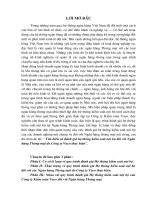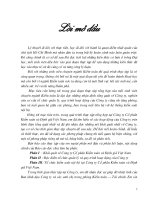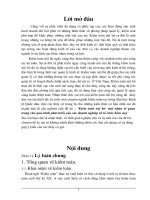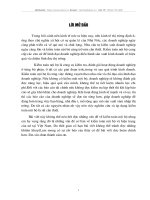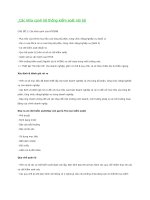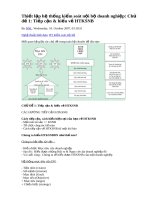Writing tip vol2 PwC nội bộ
Bạn đang xem bản rút gọn của tài liệu. Xem và tải ngay bản đầy đủ của tài liệu tại đây (4.56 MB, 130 trang )
Learning & Development
Writing Tips
second edition
A collection of tips from English Business Writing courses
For internal use only
Writing Tips
second edition
A collection of tips from English Business Writing courses
Learning & Development
PricewaterhouseCoopers
2
Preface to the Second Edition
The real benefit of a business writing course comes after the
training has been completed. Participants apply what they have
learnt once they start real work. This writing tips booklet is
designed to make the learning process much easier and quicker,
and to help participants retain the knowledge gained from the
training courses.
Background
English Business Writing 1, 2, and 3 are courses designed to
conform to the firm’s requirements for improving staff’s writing
skill. During these courses, many participants have asked good,
relevant questions. The answers and explanations were written
on the flipcharts. These explanations, including grammar notes,
tips on language usage, common Thai errors, etc. are useful,
and we thought that they would be even more useful if compiled
in a handy, accessible format. For that reason, we have
transformed them into a booklet which we hope will be valuable
for all of you to keep as your small handy writing tips reference.
This second edition represents an extensive revision of the
parts in the first edition. Part 1 includes a new unit on “
Prepositions” which is one of the most difficult areas in English
grammar. This part was written by Bernie Gilman during his
English consultancy work at PwC Bangkok (August – December
2007). Apart from that, there is a substantial enlargement in
Part 2 which consists of words, phrases and writing tips from
PwC English editors and partners.
3
How to use the booklet
You can make your way through the whole booklet, or
alternatively just look for key words from the index at the back
which includes all major words from the 2 main parts: Tips from
EBW 1-2-3 and List of common errors. The last part of this
booklet allows you to “Test Your Basic Writing Skills”. This
test is quite fun to do and you can even share it with your
colleagues!
Limitations & Where to get help
There is a lot to gain from this booklet, but it does have
limitations. The main one is that it cannot tell you whether your
writing is acceptable. If you need further help, follow the
suggestions below.
• Ask a colleague who you know writes well to read your work
and give you feedback.
• You may be able to attend a training course. These are
usually run firm-wide or for specific business units that wish
to improve their performance in this area. Speak to your
coach or contact L&D
• Contact the English editors in L&D or editors in your office
if you have any questions about English writing or would
like to discuss a particular issue.
L&D
Bangkok, Thailand
April 2008
4
Writing Tips Team
Editor-in-chief
Lakana Pintong, L&D
Contributors/Editors
Bernie Gilman, BitS (Thailand): Prepositions
Moray Clark, BitS (Thailand): Tips from EBW1-2-3
Lists of common errors
Dominic Ireland, English editor
Sarah Francis, English editor
Layout
Marketing & Communications Department
Special thanks to
Anothai Leekitwattana and Kittima Bunnag for their great
support in the first edition.
First edition published January 2007
Any queries? Contact Lakana Pintong (ext. 4644)
5
Table of contents
Preface......................................................................................2
Part 1.........................................................................................6
• Tips from EBW 1-2-3.........................................................6
• Prepositions........................................................................29
• Articles................................................................................85
Part 2.......................................................................................96
• List of common errors.......................................................96
• Singular vs Plural...............................................................99
• British vs American spelling.............................................101
• Casual vs Formal..............................................................102
• Replacement for phrase....................................................103
• Sounds the same..............................................................107
• Hyphens.............................................................................108
• Time frames.......................................................................108
• Appropriateness.................................................................109
• Phrases..............................................................................110
• Assorted tips......................................................................111
Part 3.....................................................................................114
• Test Your Basic Writing Skills...........................................114
Index.....................................................................................123
6
Rules and techniques for business writing
1. Communicate the message
2. Set the right tone
3. Use simple words
4. Use the “YOU” approach
5. Use short words
6. Use a clear sentence structure
7. Use clear punctuation
8. Use a clear paragraph structure
The structure of a memo
• Subject
• Dear…………
• Brief introduction
• Assignment
• Results (not more than 5)
- Brief outline of current situation
- Problem
- Solution / recommendations
• Offer of further information
• Invitation to meet
• Polite close
• Yours………….
The structure of a letter
• Dear
• Reason
• Main message
• Polite closing
• Yours truly
7
Requesting information and action
The list below shows structures used to introduce a request on
a scale from direct to indirect (very polite). It also shows which
phrases can be used to introduce a request for action and
a request for information.
Action
• Please + order
Information
direct
• Please tell me…
• I want you to…
• Do you know…
• Can you…
• Can you tell me…
• Will you…
• Will you tell me…
• Could you…
• Could you tell me…., please
• I’d like you to…
• I’d like to ask you…
• I’d like to ask you…
• I’d like to know…
• Do you happen to know…
• Perhaps you could…
• Perhaps you could tell me…
• Could you possibly…
• Could you possibly tell me…
• Do you think you
could…
• Do you think you could
tell me…
• Would you mind +
v.ing…
• Would you mind telling me…
• I wonder if you
could…
• I wonder if you could tell me...
• Do you think I could ask you...
• I wonder if you’d
mind + v.ing…
• I wonder if you’d mind
my asking you…
• I was wondering if
you could...
• I was wondering if you
could tell me…
• I was wondering if you’d
mind telling me…
indirect
8
According to
We use according to when we want to say that our information
comes from some other person, book, etc. It means something
like ‘if what X says is true’.
According to Thai law, you must pay income tax.
(Thai law says)
According to Somsak, the new secretary is really nice.
(Somsak says)
According to next week’s training, I have prepared
a presentation.
According to the opinion of ........
Referring to next week’s training, I have prepared
a presentation.
According to is not generally used with words like view or
opinion.
9
Amount
A. Uses
amount / amounting + to
1. To add up in number or quantity: The purchases amounted
to 50 dollars.
2. To add up in importance or effect: That plan will never
amount to anything.
3. To be equal to: accusations that amount to
an indictment.
(in the amount of + noun) = the total amount of something
B. Sample sentences
is / costs
A new laptop amounts to 30,000.- bht.
is
His salary amounts to 50,000.- bht/month
noun
verb
The company’s fixed assets amount to THB 20M.
noun
verb
Last year, total sales amounted to THB 3M.
sentence
preposition phrase
The company has fixed assets amounting to THB 20M.
sentence
preposition phrase
Last year, they registered total sales amounting to THB 3M.
The company owns assets in the amount of THB 15M.
10
Appreciate
Appreciate (v.) = like (v.)
Sample sentences
I would like it ……….
I would appreciate it if you could……………
It would be appreciated
I would be appreciated it if you could call me as soon as
possible.
Attach
When writing about email attachments, you should follow the
structures below:
I attach the files as follows:
I attach the following files:
I have attached + noun
Please find the attached + noun
I attached
Attached herewith.
I have enclosed
11
Company names
The names of companies and other organisations are
usually regarded as singular, regardless of their ending:
General Motors has announced its fall lineup of new
vehicles.
Try to avoid the inconsistency that is almost inevitable when
you think of corporate entities as a group of individuals:
General Motors has announced their fall lineup of new
vehicles.
But note that some inconsistency is acceptable in all but the
most formal writing:
Ford has announced its breakup with Firestone Tires.Their
cars will no longer use tires built by Firestone.
Some writers will use a plural verb when a plural construction
such as “Associates” is part of the company’s title or when the
title consists of a series of names:
Upton, Vernon, and Gridley are moving to new law offices
next week or
Shadrach, Meshach, Abednego & Associates have won all
their cases this year.
Singular verbs and pronouns would be correct in those
sentences, also.
Note that “the number” is a singular collective noun:
The number of applicants is steadily increasing.
“A number,” on the other hand, is a quantity expression.
Its meaning is similar to some.
There are several students in the lobby. A number are
here to see the president.
12
Competition
Word families
Compete (v.)
Competitor (n.)
Competitive (adj.)
He won a flat screen TV in a UBC competition. = a game
are
competitors = market comp.
There is a lot of competition in the consumer banking
industry.
(adj.)
The consumer banking industry is highly competitive.
(companies)
VISA and Master card are competitors.
VISA is a competitor of Master card.
Concern
1. Concern (v.) = be related to/involve
IT concerns computers
CS concerns satisfaction.
CS is concerned with satisfaction.
IT is concerned with computers
2. Concern (v.) = worry/scare
Pollution concerns me
I am concerned about pollution.
I am worried about pollution
* IT = Information Technology
CS = Customer Service
13
Describing trends
Trends are changes or movements. These changes are
normally in numerical items, e.g. cost, production volumes, or
unemployment. There are three basic trends. Now let’s look at
the language of trends in more detail.
Verbs
Transitive
Intransitive
increase
raise
put/push/
step up
increase
rise
go/be up
grow
extend
expand
boom
extend
expand
Verbs
Transitive
Intransitive
decrease
decrease
fall
drop
go/be down
decline
drop
put/push
down
cut
reduce
collapse
slump
Nouns
increase
rise
growth
extension
expansion
boom
(dramatic rise)
Nouns
decrease
fall
drop
decline
cut
reduction
collapse
(dramatic fall)
slump
(dramatic fall)
14
Verbs
Transitive
Intransitive
keep/hold…stable/
constant
remain stable
Maintain…(at the
same level)
stay constant
Nouns
stability
Sometimes we need to give more information about a trend,
as follows:
There has been a slight increase in the value of the dollar.
(the degree of change)
Share prices fell rapidly on the London Stock Exchange
today. (the speed of change)
Remember that we modify a noun with an adjective (a slight
increase); and a verb with an adverb (to increase slightly).
15
Describing the degree of change
dramatically
vast(ly)
huge(ly)
enormous(ly)
substantial(ly)
considerable/considerably
significant(ly)
moderate(ly)
slight(ly)
a little
Describing the speed of change
rapid(ly)
quick(ly)
swift(ly)
gradual(ly)
slow(ly)
16
Experience
Experience (uncount. noun) = knowledge from work
Our professionals have extensive experience.
Experience (count. noun) = event
Swimming with dolphins is a great experience.
She had a lot of frightening experiences while travelling
through Iraq.
Final comments phrases
A. Uses
At the final comments part of your emails or letters, you may
use the basics phrases below.
Remember to put “s” if the noun that follows “any” is countable.
Any suggestions, problems, questions, ideas.
B. Sample sentences
Just give me a call if you have any questions.
Do not hesitate to contact me if you require any further
information.
Please feel free to contact me if you have any questions.
17
F-A-N-B-O-Y-S
FANBOYS is a handy mnemonic device for remembering the
coordinating conjunctions:
For, And, Nor, But, Or, Yet, So
complete thought
FA
N
B
O
YS
You should always have a comma before FANBOYS that join
two complete thoughts (with two subjects and two verbs).
complete thought
You wore a lovely hat, but you didn’t wear anything else.
My hamster loved to play, so I gave him a hula-hoop
N
FA
complete thought
B
O
YS
If you do not have two subjects and two verbs separated by
the FANBOYS, you do not need to insert the comma before
the FANBOYS. In other words, if the second grouping of words
isn’t a complete thought, don’t use a comma:
not a complete thought
You wore a lovely hat but didn’t wear anything else.
My hamster loved to play and often ate marshmallows.
18
Follow
“Follow” is used to introduce a specified enumeration,
explanation, or command. It means “as will be stated next”.
•The list (singular)of names follows:
•The key stages (plural) follow:
Our fees follow:
A summary of our fees follows:
“Following”
I attach the following (adj) documents:
I attach the following: (adj)
We have found the following:
We have made the following findings:
“As follows”
are as follows
as follow
as following
as followings
the followings
I have three questions, as follows: (Adv)
I have outlined the requests, as follows:
19
Grateful
A. Uses
Grateful (adj.) = happy (adj.), thankful (adj.)
We use “grateful” to express our warm or deep
appreciation for kindness or benefits received:
I am grateful to you for your help.
B. Sample sentences
I would be grateful if you could…….
happy………….
Manufacture
The company’s core business is manufacturing.
The company is engaged in manufacturing.
The company is a manufacturer.
Company
Business/activity
Manufacturer
Manufacturing
Distributor
Distribution
Retailer
Retail
Vendor
Sales
20
Person
A. Uses
The usual plural of person is people.
Only one person turned up.
A lot of people replied to our advert.
People meaning ‘more than one person’ is already plural and
cannot form a plural with ‘s’. It always takes a plural verb:
Most people are basically honest.
People are dying of starvation every day. ( People is
dying…)
People meaning ‘race’ or ‘nation’ is countable and you can add
‘s’ in the normal way:
the peoples of South East Asia.
Persons is very formal and used, for example, in official
language, such as in legal documents:
He was murdered by a person or persons unknown.
You may also see it on official notices:
This elevator may only carry eight persons.
Prepositions
I will
present
recommend
suggest
explain
something
to
someone
share
confirm
something
with
someone
21
Refer
A. Uses
Refer to something: If you refer to the appendix at the end of
the contract, you will find all the numbers of the components.
B. Sample sentences
Referring to your letter of 31 May 2006, I…..
With reference to………,
I refer to your letter of 31 May 2006.
Regard, Refer
Regarding…
Referring to…
With reference to…
the product’s price
With regard to…
Semi-colons
1. sentence; sentence
clear logical link
Consumers spent a lot last month; therefore, the economy
expanded.
2. Lists within lists
There are a number of key markets:
Colon introduce a list
Thailand, Laos, and Cambodia; Dubai, Bahrain, and Saudi Arabia;
and Germany, France, and Holland.
They won the battle; however, they lost the war.
22
Singular - Plural
In English, for countable nouns, plurals are default.
1
child
staff
person
2
children
staffs
people
Single
0
0.5
1
Plural
1.1
2
100
There are 0 people.
There are 0.9 people.
This harvest produces 0.75 kilograms of dried alfalfa.
Freezing point of water is 0 degrees Celsius.Boiling point of
water is 100 degrees Celsius.
Remember: Use a singular noun ONLY if you are sure you
are talking about ONE. More than one, less than one, or
an unknown number are all plural.
23
Time: from, between, during
A. Uses
From is normally used with to or till/until:
Most people work from nine to five.
between – and can also be used with the same meaning.
During is used with known periods of time, i.e.
during the Middle Ages
during his childhood
during my holidays
B. Sample sentences
I use an
umbrella
from
between
during
May
to
and
the rainy season.
October.
24
that….should
A: Uses
that….should is more formal than a gerund or infinitive
construction and usually implies less direct contact between the
advisers/organizers etc. and the people who are to carry out
the action.
Verbs which can be used with that….should include the
following:
Insist, order, propose, ask, beg, command, decide,
demand, determine, insist, order, propose, recommend,
request, stipulate, suggest, urge.
B: Sample sentences
She advised that we should keep the gate locked.
She advised that the gate should be kept locked.
She advised keeping the gate locked/advised us to keep it
locked.
Recommend could be used above instead of advise and
would sound more formal
I
suggest
something to someone
recommend
the banyan tree restaurant.(to you)
eating at the Banyan Tree
v-ing
that you
eat at the Banyan Tree
visit Phuket.
outsource these services
that + someone + v1
I will recommend you to my boss.
